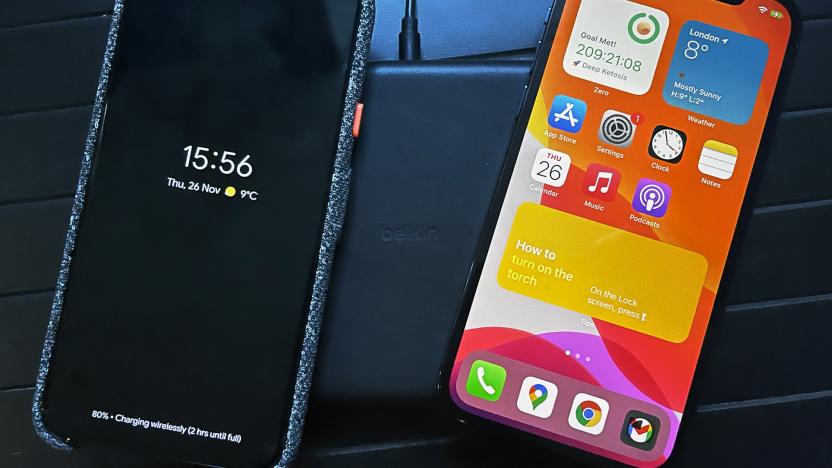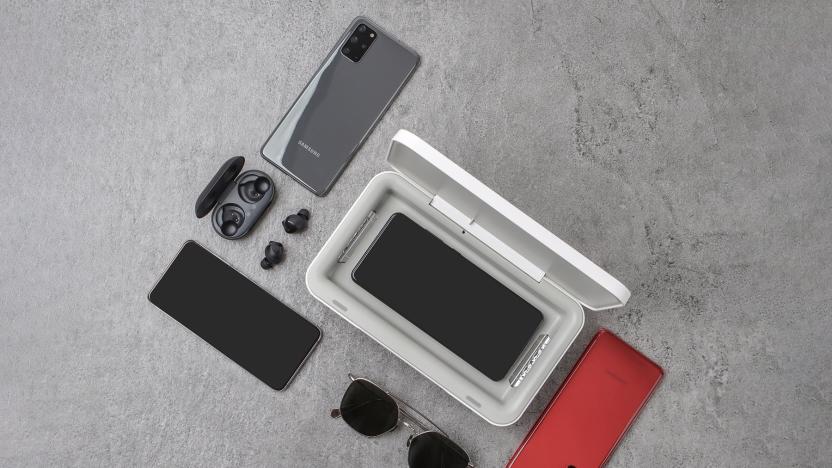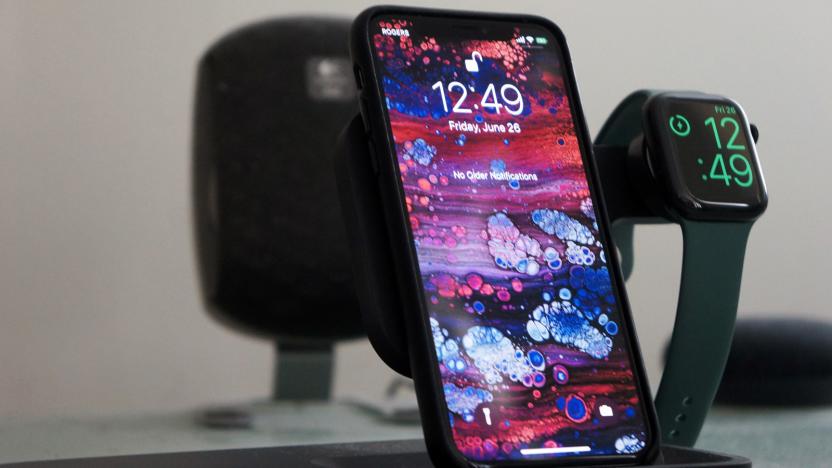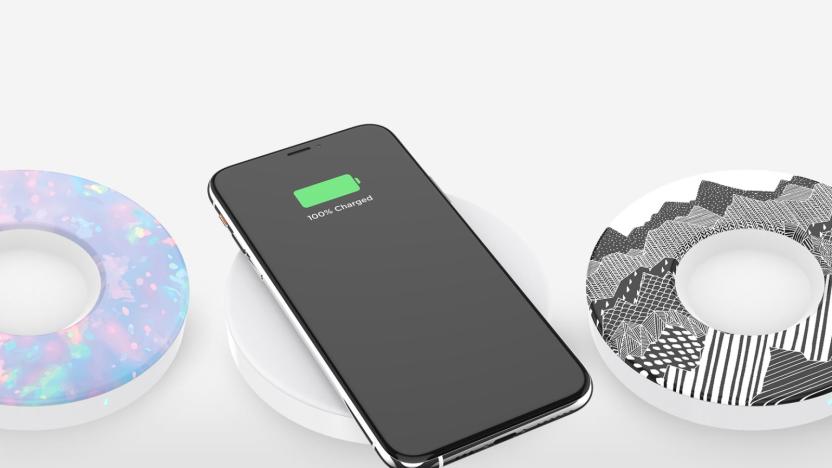wireless charger
Latest

The first weird gadget of CES 2023 is Lenovo's Swiss Army lamp
CES 2023 usually features some pretty kooky gadgets, and Lenovo is kicking off that trend with the Go Desk Station with Webcam.
Steve Dent12.20.2022
Belkin’s new wireless charger tries to do what AirPower promised
Wireless chargers are available almost everywhere now, but they're finicky. Belkin’s TrueFreedom Pro Wireless Charger is a charging mat that sidesteps the issue of having to precisely position your devices, by stacking 16 Charging coils across the mat.
Mat Smith11.27.2020
Samsung is selling a wireless charger that also sterilizes your phone
In a bid to give its customers an phone-cleaning option that doesn’t involve an antibacterial wipe, Samsung has begun selling a wireless UV charger that promises to “kill up to 99 percent of bacteria within 10 minutes.” The ITFIT UV Sterilizer is a very unremarkable white box that Samsung says is spacious enough to fit a Galaxy S20 Ultra. The embedded 10-watt Qi charger will deliver power while it does its thing.
Matt Brian07.02.2020
Logitech’s Powered 3-in-1 Dock makes a case for premium wireless chargers
Logitech's Powered 3-in-1 Dock may be a pricey wireless charger, but it's worth the premium.
Jon Fingas06.29.2020
PopSockets unveils a wireless charger that makes space for PopGrips
Thanks to a new device by PopSockets, you'll no longer have to remove your PopGrip to wirelessly charge your phone. At CES today, PopSockets unveiled its PopPower Home Charger, a wireless charging pad that looks something like a donut. PopGrips fit into the recess in the center, so they won't get in the way of charging.
Christine Fisher01.07.2020
The best Qi wireless charging power banks
By Nick Guy This post was done in partnership with Wirecutter. When readers choose to buy Wirecutter's independently chosen editorial picks, Wirecutter and Engadget may earn affiliate commission. Read the full Qi wireless charging power banks guide here. After testing nine competitors over 10 hours, we're confident that Energizer's QE10000CQ 10K Wireless Charging Power Bank is the best all-in-one option for anyone looking for the convenience of a Qi wireless charger at a desk and the portability of a power bank on the go. It also has the fastest ports, and you can charge two devices and the battery itself at the same time. The Energizer QE10000CQ offers better grip on its wireless charging surface than the competition, ensuring that your phone stays in place and keeps charging. It has roughly the same footprint as an iPhone XS but measures about twice as thick, and it's equipped with the best combination of charging options we could find: two USB-A ports (one of which supports Quick Charge 3.0 charging), a Micro-USB input, and a USB-C port for both input and output. (You can fast-charge supported devices through the USB-C port if you have the right cable.) It can fully charge most phones three times before needing to be recharged itself; that's as much battery capacity as we saw from any Qi power bank available during our testing period. myCharge's Unplugged 5K is a good option if you prefer a small, inexpensive charger and are willing to make a few sacrifices. It's more affordable than the Energizer but has half the battery capacity (most phones can get about one and a half to two full charges from this myCharge model). In our tests, the Unplugged 5K wirelessly charged just as quickly as the Energizer, getting a fully drained phone to about 30 percent after an hour. Through the two USB-A output ports, you can expect charging speeds at least twice as fast as with wireless charging, but the unit doesn't offer a USB-C port for even faster charging than that. The white plastic body flexes when you press against it, and this power bank has less grip for keeping your phone in place.
Wirecutter03.15.2019
Rubix's wireless battery sticks to your phone with magnets
When you're spending most part of the day out and about, chances are at some point you'll have to whip out your portable battery to juice up your smartphone. This usually means stacking your phone on top of a cable-wrapped power bank, and then clumsily holding everything together with one hand. Doesn't sound very 2015, does it? It's annoying enough for a startup called Rubix to come up with a solution: slap a magnetized Qi wireless charging case (aka On Case) on your phone, and then let it snap onto a magnetized wireless charging battery (aka On Charger). Look ma, no cable!
Richard Lai04.27.2015
Engadget giveaway: win a Nexus 5 and wireless charger courtesy of iOttie!
The art of automotive zen begins with a clean and orderly interior (for most drivers) and this week's giveaway is sure to help provide a more cable-free ride. The case, cradle and charger folks at iOttie have done us a solid by offering two Engadget readers the new Easy Flex Wireless car charger and a Nexus 5 smartphone. This Qi-enabled, dash-mountable charger will help drivers keep their hands at two and ten nine and three like they're supposed to, while still providing visibility for turn-by-turn directions and a steady stream of juice. The charger's sticky gel pad will keep Google's latest handset from taking a dive to the floorboards and the device will even work with other Qi-compatible smartphones. All you need to do is head down to the Rafflecopter widget below for up to three chances at winning one of these prize packs. You never know, a little dose of automotive feng shui could turn that long nightmare of a commute into some peaceful "me" time. Update: PSA - The DMV has apparently changed its age old hands-on-the-steering-wheel specifications. Drive safe kids and be sure to keep your hands at nine and three. The more you know... Winners: congratulations to John P., Edgewater Park, NJ and Martin S., El Granada, CA.
Jon Turi04.15.2014
Nexus 4 Wireless Charger hands-on
Palm's Touchstone dock immediately came to mind when we first saw LG's Nexus 4 Wireless Charger last fall (now available for $60 in the Play Store). Both devices are circular, with a micro-USB port in back and a slanted front surface on which to rest the phone. That's where the similarities end -- while the Touchstone is cylindrical and uses a proprietary wireless charging system, the Nexus 4 Wireless Charger is larger, spherical and Qi-compatible. Another major difference is that Palm's dock uses permanent magnets to line up and secure the handset, and LG's accessory relies primarily on the friction / suction between a rubber ring and the glass back of Google's flagship phone. Design-wise the Nexus 4 Wireless Charger looks similar to a smaller Nexus Q cut in half, down to the matching recessed square connector cutout. In the box you'll find a 5V 1.8A AC adapter (vs. 1.2A for the one supplied with the Nexus 4) along with a micro-USB cable (longer than the one provided with the handset). The manual warns to "use only the power adapter and micro-USB cable that come with your Nexus 4 Wireless Charger", but we didn't have any trouble with other USB power sources beyond longer charging times. We tested the dock with the Nexus 4, Droid DNA, Lumia 920 and Lumia 822 (with the optional Wireless Charging Cover) -- basically, LG's accessory provides the same experience as Nokia's Wireless Charging Plate ($50), which is also Qi-compatible. The $10 difference buys you a matching design and a spare USB power adapter and micro-USB cable (Nokia's plate comes with a proprietary AC adapter). It takes about 4 hours to fully charge Google's flagship phone using wireless power -- check out the gallery above for some action shots.
Myriam Joire02.17.2013
Alliance for Wireless Power approves its specification, edges closer to truly cable-free charging
Design by committee might not be the death knell for technology after all. Over four months after the Alliance for Wireless Power was founded in earnest, the coalition has already greenlit a specification for its partners to work from. The guideline lets device makers start building devices that charge through a magnetic resonance technology more forgiving of distance and material than Qi while simplifying the process through short-range wireless formats like Bluetooth 4.0. While the A4WP group hasn't made all the details public, it's holding meetings this week to speed up the commercialization process -- it's here that we'll learn whether the corporate bureaucracy is just as quick at getting wireless charging hardware into our hands as it is handshaking on standards.
Jon Fingas10.30.2012
LaunchPort releasing AP.3 sleeve for juicing your new iPad the inductive way
LaunchPort is finally releasing a sleeve for the new iPad, which makes it compatible with the company's inductive charging gear. It goes on sale in September for a hefty $149, and of course, you'll also need at least one $199 tabletop or wall mount to connect it to. The sleeve also works with the iPad 2, and if you're thinking about getting one, be quick -- it's only a matter of time before resonance charging renders inductive juicing a little passé.
Jamie Rigg08.30.2012
Intel, IDT to make resonance charging a reality, see reference chipset coming in first half of 2013
Intel has been talking up wireless charging for years, to the point where we thought its implementation would forever remain a concept for the lab. Not so: Intel is having Integrated Device Technology (IDT) build a real-world chipset to support resonance charging in our gadgets. The lofty goal is to have a ready-made platform for charging up a mobile device or peripheral just by keeping it close to another device with a charger built-in, such as an Ultrabook; there's none of the unseemly contact plates used with inductive wireless power. Intel's commitment is still very much early and won't put a full, two-way resonance chipset into the hands of hardware makers until sometime during the first half of 2013, let alone into a shipping product. We'll take it all the same, as it just might be the first step toward embracing wireless power on a truly large scale.
Jon Fingas08.29.2012
Verizon-branded Galaxy S III wireless charging kit starts showing up at retail stores
Back when we met the Galaxy S III for the very first time, Samsung promised a wireless charging solution would be coming soon to its sleek and potent slab. Unfortunately, Sammy's power-boosting companion's been hit by hapless delays that have prevented it from seeing the light of day. Now, thanks to a few recent shots from Phone Arena, it looks like at least some S3 owners could see a bundle in the near future, albeit not the official one from the Korean outfit. According to the site's kind tipster, Verizon's allegedly pricing the charging station at $50, while the rear case is expected to be around $40 -- making it about $90 for the entire kit. Naturally, this could change at any given moment, but hey, at least we know it's out there.
Edgar Alvarez08.04.2012
WPC updates Qi standard, increases inductive charging distance to 40mm
It seems that Power Matt just got a bit more, er, powerful. The Wireless Power Consortium announced today that it's improved the Qi inductive-charging standard to "include longer range magnetic resonance wireless charging." Effectively, this means charging stations that are up to spec will be able to transmit up to 5 watts of power from distances of 40mm (up from 5mm, previously) to Qi-enabled devices. The WPC says it's ideal for pushing power through the likes tables and counter tops, and that it currently has 12 types of compatible transmitters ready for action. All in all, it certainly seems like a solid step for finally getting rid of all that cable clutter at your workstation -- especially if it'll rid users of those less-than-pretty looking charging bases. Maybe a last-minute add-on to your Uppleva, IKEA?
Joe Pollicino04.20.2012
Chrysler's Mopar division brings wireless charging to 2013 Dodge Dart (video)
The idea isn't new to the aftermarket crowd, but Mopar has just announced the summer arrival of the industry's first OEM wireless power mat, which is designed specifically for the 2013 Dodge Dart. It'll fit snugly within the center console tray, and will charge any properly equipped MP3 player or smartphone. The power mat will retail for $200 and will be available from Chrysler's network of dealers. As for the 2013 Dart itself, it'll set you back a mere $15,995. You'll find an inside peek at Mopar's solution, along with the full PR, right after the break.
Zachary Lutz04.10.2012
The Engadget Interview: Duracell President Stassi Anastassov on future battery tech (video)
It's 2012, and we're connected to the web every second of every day. And then, near the end of each daily cycle, it all stops. "My battery is dead." Is it really your battery that's become depleted? Of course it's not, though it certainly feels as though it might as well be. Stassi Anastassov experiences that daily setback just like you and I and the rest of the world. But the Duracell President and long-time Procter and Gamble executive is in a position to find a way around it, and that's exactly what he plans to do. We sat down with Anastassov in our New York City office to chat about the past, present and future of battery tech, and we even had a chance to meet the Duracell Bunny (yes, that furry hare was property of the "Trusted Everywhere" company long before it made its move to Energizer). So how does P&G plan to transform the portable power industry, and what's that Duracell Powermat joint venture all about? You'll find the answers to those questions and more in our interview just past the break.
Zach Honig02.16.2012
Hertz charges into EV Plugless Power pilot program, can't say it three times fast
Hertz has been offering up electric vehicles amongst its fleet of rental cars, and now it's getting ready to pull the plug. The company is teaming with Evatran to test out the those cool little Plugless Power discs, installing some at its corporate headquarters this month. Hertz, along with a number of other companies will be logging "feedback on daily usage routines, user interfaces, and any additional functionality needed." No word on when such technology might see wider distribution.
Brian Heater02.10.2012
Oregon Scientific at CES 2012: new weather monitoring and a Qi charging stations, an action cam and more
As usual, the folks at Oregon Scientific are rolling out a bundle of products at CES. When the weather gets bad, the company's new Portable Emergency Alert Radio can come to your rescue to keep you updated as the world ends (it is 2012, after all) for $79. It can tune into AM/FM radio, NOAA weather radio, and Specific Area Message Encoding (SAME) location-based alerts, plus it can be charged via its solar panel or hand crank -- and a USB port's on board to keep all your other devices in the juice, too. There's the ATCMini action video camera that joins the company's other, action cam offerings. The ATCMini weighs a scant 2.3 ounces and records 720p video at 30fps, shoot 1.3 megapixel stills and is waterproof up to 65 feet (20m). It stores all your pics and vids on a MicroSD card, and you can show off your extreme exploits on the big screen via a TV-out jack. The action cam comes with a helmet mount, but there are handlebar, surfboard, and skateboard mounts sold separately as well. PR and a gallery of either awaits you below, and stay tuned for our hands-on impressions later today. Update: Don't forget to peep the Time and Wireless Charging Station+ and the Remote Weather Access Platform.
Michael Gorman01.08.2012
Rohm Wireless Power Transmission system hands-on (video)
Wireless power demos abound at CEATEC, and Rohm Semiconductor had their own variant on hand with a complete mix of direct-draw gadgets, along with the omnipresent charging iPhone 4 (or was it a 4S?). Like Murata's prototype, the Rohm flavor uses square electrodes instead of the coils that you'll find in traditional wireless power solutions, like Qi. But unlike that seemingly identical solution from Murata, this version supports much greater power efficiency -- something in the 92 to 93 percent range (compared to the competing pad's 70-percent efficiency rating). That means that the prototype that we're looking at here loses just seven to eight percent of power during transmission -- which is still unacceptably high, mind you, but far more tolerable. Rohm's Wireless Power Transmission system also allows you to charge or power devices by placing them anywhere on the pad, rather than directly over charging positions, and it supports much greater transmission, with one prototype outputting up to 100 watts. Since power efficiency isn't something we could verify visually, what we could see at the company's demo did appear to work quite well. Powering a gadget is as simple as dropping it on the pad. Well, resting it gently -- this is a prototype we're talking about, after all. The 50-watt pad was able to power a fan, LED light, and a couple of charging smartphones without issue. The light and fan jumped to full power as soon as they made contact. A second pad got the juices flowing to a large OLED light panel, which was plenty bright when positioned on its own pad, but glowed quite dim when joining other devices. There weren't any charging laptops on hand, like we saw over at Murata, but with power output at 50 and 100 watts, either pad could theoretically support it. Like many of the prototypes we've seen at CEATEC, there aren't any plans to actually bring the system to market, but the technology could be used in other devices. We go hands-on after the break.%Gallery-135773%
Zach Honig10.06.2011
Murata Wireless Power Transmission System supports laptops, we go hands-on (video)
Do we really need another wireless charging system that's incompatible with industry standards? Murata seems to think that we do. The company's prototype uses neither conductive nor inductive transmission, instead bringing its new capacitive coupling technology to the cordless charging mix. Capacitive coupling uses square transmitter and receiver electrodes, instead of the coils used with Qi devices. It also doesn't require a physical connection like near-obsolete conductive tech, which dictates that both the charging pad and receiving device use metal connectors that must be joined to transfer current. The Murata system is far from being production-ready, with only 70 percent efficiency (30 percent of electricity is lost during transmission). The sample the company had on hand can support 16 watts of output with a maximum of 2.1 amps, making each pad capable of charging several small gadgets, or one larger device, like a laptop. Murata seemed more interested in demonstrating the concept behind capacitive coupling than actually proving that it works -- the laptop we saw "charging" was a plastic mockup, though the base did glow red when the laptop's charging pad came into contact (though it also glowed blue at times, as you can see in the image above). We did take a close look at an iPhone case, however, which appeared to be remarkably thin -- much thinner than models from Powermat, for example, though the case does extend below the dock connector. Another advantage of the square electrodes is that you don't need to place devices in a certain position on the mat in order for them to charge -- they simply need to be positioned within the general charging area. We take a closer look in the video after the break.%Gallery-135770%
Zach Honig10.05.2011